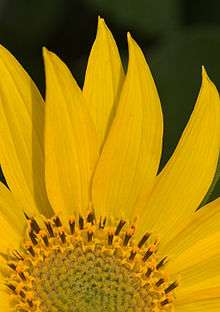Balsamorhiza deltoidea
| Balsamorhiza deltoidea | |
|---|---|
 | |
| disc florets and ray florets | |
| Scientific classification | |
| Kingdom: | Plantae |
| (unranked): | Angiosperms |
| (unranked): | Eudicots |
| (unranked): | Asterids |
| Order: | Asterales |
| Family: | Asteraceae |
| Tribe: | Heliantheae |
| Genus: | Balsamorhiza |
| Species: | B. deltoidea |
| Binomial name | |
| Balsamorhiza deltoidea Nutt. | |
| Synonyms[1] | |
|
Balsamorhiza glabrescens Benth. | |
Balsamorhiza deltoidea is a species of flowering plant in the sunflower tribe of the plant family Asteraceae known by the common name deltoid balsamroot. It is native to western North America from British Columbia to California, where it grows in many types of generally mountainous habitat.[2][3]
Description
Balsamorhiza deltoidea is a taprooted perennial herb growing erect to a maximum height near 90 centimeters (35 inches). The stems are hairy and glandular. The large leaves are up to 25 centimeters (9.8 inches) long and 20 cm (7.9 in) wide, and are roughly triangular in shape, hairy and glandular, and often toothed along the edges.[4]
The inflorescence bears usually one or sometimes a few large flower heads, each lined with hairy, pointed phyllaries up to 4 centimeters (1.6 inches) long. The head has a center of yellowish disc florets and a fringe of pointed yellow ray florets each up to 4 or 5 centimeters (1.6 or 2.0 inches) long. The fruit is an achene 7 to 8 millimeters (0.28 to 0.31 inches) in length.[4]
Uses
Deltoid balsamroot has been used as a food and medicinal plant by Native Americans. The seeds were eaten raw or cooked, and sometimes ground up and made into breads or cakes. The roots were also eaten, either raw or cooked, and when roasted make a coffee substitute. Young shoots were also eaten as a fresh green. The roots were also used to treat colds.[5]
References
- ↑ The Plant List, Balsamorhiza deltoidea Nutt.
- ↑ Biota of North America Program 2014 county distribution map
- ↑ Calflora taxon report, University of California, Balsamorhiza deltoidea Nutt., Balsam deltoid, deltoid balsam root, deltoid balsamroot
- 1 2 Flora of North America, Balsamorhiza deltoidea Nuttall, Trans. Amer. Philos. Soc., n. s. 7: 351. 1840.
- ↑ Plants for a Future Database Balsamorhiza deltoidea
External links
 Media related to Balsamorhiza deltoidea at Wikimedia Commons
Media related to Balsamorhiza deltoidea at Wikimedia Commons- Jepson Manual Treatment - Balsamorhiza deltoidea
- USDA Plants Profile for Balsamorhiza deltoidea (deltoid balsamroot)
- Balsamorhiza deltoidea - Calphotos Photo gallery, University of California
